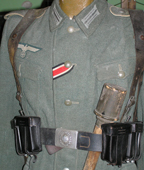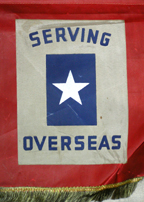2008 EXHIBIT:
Beaver’s Greatest Generation
Display Honors Beaver Area Heroes of World War II
 The Beaver Area Heritage Museum’s new display honors “Beaver’s Greatest Generation,” the men and women whose sacrifices secured the freedom and democracy we have today. Borrowing its title from Tom Brokaw’s book on World War II, the museum’s spring 2008 exhibit inspires appreciation for the generations who fought overseas and worked tirelessly at home to win the war and create a strong country for their children and grandchildren.
The Beaver Area Heritage Museum’s new display honors “Beaver’s Greatest Generation,” the men and women whose sacrifices secured the freedom and democracy we have today. Borrowing its title from Tom Brokaw’s book on World War II, the museum’s spring 2008 exhibit inspires appreciation for the generations who fought overseas and worked tirelessly at home to win the war and create a strong country for their children and grandchildren.
The exhibit uses period music, photographs, educational posters, videos and variedof souvenirs to convey the spirit of unity and sacrifice of our local heroes and heroines. Brought up during the Depression, the Greatest Generation struggled through youth knowing nothing of the amenities we take for granted today, and grew up on the world’s horrific battlefields.
 Among these youths was Dale Karger, believed to be the youngest pilot to achieve “Ace” status, and one of very, very few pilots to engage and shoot down one of Germany’s secret weapons, the Messerschmitt Me-262 jet fighter. He was awarded the Distinguished Flying Cross in addition to 10 Air Medals — all at the ripe old age of 20! On loan from Karger is a bullet-riddled swastika that hung in the Nuremburg Stadium where Nazi leader Adolf Hitler made many major speeches.
Among these youths was Dale Karger, believed to be the youngest pilot to achieve “Ace” status, and one of very, very few pilots to engage and shoot down one of Germany’s secret weapons, the Messerschmitt Me-262 jet fighter. He was awarded the Distinguished Flying Cross in addition to 10 Air Medals — all at the ripe old age of 20! On loan from Karger is a bullet-riddled swastika that hung in the Nuremburg Stadium where Nazi leader Adolf Hitler made many major speeches.
 Another local hero is Zack Wallover, a fiercely proud Marine who fought in many of the most brutal battles in history and somehow managed to live to tell the tale. Wallover was friends with Joseph Rosenthal, who took the most famous, most reproduced photo in history, showing the flag raisers on Iwo Jima for the Associated Press.
Another local hero is Zack Wallover, a fiercely proud Marine who fought in many of the most brutal battles in history and somehow managed to live to tell the tale. Wallover was friends with Joseph Rosenthal, who took the most famous, most reproduced photo in history, showing the flag raisers on Iwo Jima for the Associated Press.
The stories of Karger, Wallover, and other heroes have been recorded for posterity on a video produced by Dave O’Leary, Tom Dowlin and Eric Cooper, to be played on a continuous loop during the exhibit. A range of emotions and memories are expressed — the camaraderie and excitement which made it the greatest time of the lives of some — and for others, the worst time, as memories of bloodshed and death rendered them sleepless upon their return.
 At home, sacrifices were being made as well. John McLaughlin recalls, “There was a unity in the country because everybody was scared — no money, no cars, tires, food staples, or building materials.” The educational system and medical care suffered for lack of workers. Rationing was a way of life. People grew their own vegetables in Victory Gardens, and raised their own rabbits and chickens to eat. The dress of a War Bride and Big Band music exemplify a spirit of hopefulness and perseverance that counteracted the bleak, painful, and constantly frightening reality.
At home, sacrifices were being made as well. John McLaughlin recalls, “There was a unity in the country because everybody was scared — no money, no cars, tires, food staples, or building materials.” The educational system and medical care suffered for lack of workers. Rationing was a way of life. People grew their own vegetables in Victory Gardens, and raised their own rabbits and chickens to eat. The dress of a War Bride and Big Band music exemplify a spirit of hopefulness and perseverance that counteracted the bleak, painful, and constantly frightening reality.
 Returning home triumphantly from the war, soldiers brought trophies seized from the enemy: a German uniform and medical kit, enemy weapons. They brought medals and memories, and a determination to create a better life for future generations. The Depression did not end with the New Deal; it ended with WWII, which brought a turn in the economy. Returning soldiers, for the first time, had the opportunity to go to college with the G.I. Bill. The Baby Boom began, as the suburbs flourished.
Returning home triumphantly from the war, soldiers brought trophies seized from the enemy: a German uniform and medical kit, enemy weapons. They brought medals and memories, and a determination to create a better life for future generations. The Depression did not end with the New Deal; it ended with WWII, which brought a turn in the economy. Returning soldiers, for the first time, had the opportunity to go to college with the G.I. Bill. The Baby Boom began, as the suburbs flourished.
The museum exhibits committee includes John McLaughlin (chair), Paul Semonik and Adam Fitz, with additional pro bono contributions by Brady Communications of Pittsburgh.
Click for a full list of Beaver Area servicemen who gave their lives in World War II, the full measure of sacrifice in the service of their nation.
–By Paula Soto